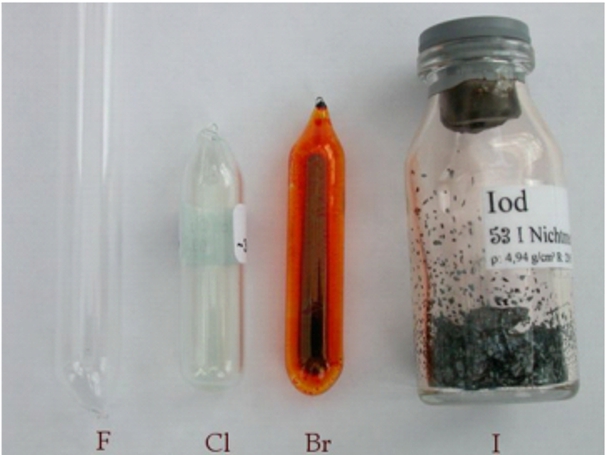The Halogens
The halogens are Fluorine (F), Chlorine (Cl), Bromine (Br), Iodine (I) and Astatine (At). The halogens, group 17 in the periodic table, have some interesting properties. They have a high nuclear charge and are therefore highly reactive. They are also unusual in that they exist in all three states; fluorine and chlorine as gases, bromine as a liquid and iodine is a solid.
Fluorine
Toxic and corrosive, it is the most reactive of all elements, it reacts with everything except oxygen, helium, neon and krypton. It reacts explosively with water to form hydrofluoric acid and oxygen.
Hydrofluoric acid is highly corrosive, it can dissolve glass, and is extremely dangerous to life. A burn the size of your hand will kill without treatment. When exposed to flesh the fluoride dissociates, the hydrogen acting as an acid and the fluorine penetrating deep into the body and combining with calcium and magnesium, thus destroying muscle and internal organs.
Fluorine is generally used as its compounds; some uses listed are below.
Hydrofluoric acid Catalyst in oil refineries, glass and metal etching,
Uranium hexafluoride Processing nuclear fuel
Fluorochemicals Plastics such as Teflon
Sodium fluoride Toothpaste
Chlorine
A toxic green gas, heavier than air and an excellent oxidising, bleaching, and disinfecting agent. In nature the main occurrence of chlorine is as sodium chloride (common salt). About 40 million tonnes of chlorine are produced each year through the electrolysis of brine (salt in solution). The chloride ion is essential to life and is mostly obtained from salt.
Chlorine is widely used in organic chemistry. About 20% of chlorine produced is used to make PVC, polyvinyl chloride ((C2H3Cl) n), which is used in piping, frames, bottles, packaging and many other uses. Other common compounds are listed below.
Calcium hypochlorite Used for bleaching and as a disinfectant, such as in pools
Potassium chlorate Explosive, used in fireworks
Chlorides Such as salt and ammonium chloride used as a fertiliser
Bromine
A red-brown liquid that is toxic as a vapour and has a bad smell, the name comes from the Greek ‘bromos’ meaning stench. It is extracted by electrolysis from bromine rich brines in China, USA and Israel, the latter from the Dead Sea. It is present in small amounts in all life but has no known biological role.
Compounds of bromine are mainly used as flame retardants and ethylene bromide is used as an insecticide. Silver bromide is used in photographic film and hydrogen bromide is used as a catalyst in organic reactions.
Iodine
A black solid that forms a purple vapour when heated. It is found in trace amounts in seawater but is commercially produced from brine. It is necessary for life, with humans requiring about 0.1mg of iodide per day. It is not common in most foods so table salt often has added iodine. Seaweed, some fish such as cod, dairy and eggs are relatively rich sources of iodine.
It is used in photography, pharmaceuticals, disinfectants, inks, dyes and animal food supplements. It is added to nylon, such as that used in vehicle tyres, for chemical stabilisation.
Astatine
Dangerously radioactive, its most stable isotope has a half life of 8 hours. There are no uses for it outside of research laboratories. It is estimated the total production to date is only a few micrograms, all of which has decayed. Because it decays so fast, little is known about its properties.
Conclusion
The toxicity of fluorine, chlorine and bromine and their compounds is seeing increased restrictions on their use. For example the use of bromine and or chlorine containing flame-retardants in circuit boards and cables is being increasingly restricted. In fact “halogen free” is becoming the norm for many applications, particularly where there is the risk of fire.

